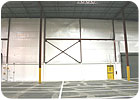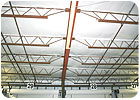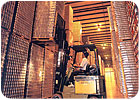
The Saddle Creek Corp., a third-party logistics company, needed an industrial warehouse site for the storage and delivery of dry and canned food products. The company located an ideal facility in Winter Haven, Fla., but the 295,000 square-foot building needed to be upgraded to ensure the facility could meet strict sanitation guidelines before it could utilize the location for the storage of everything from sugar to coffee.
A major problem involved the inside of the perimeter walls. The existing insulation was missing in some areas and torn in others. New insulation was required to meet sanitation requirements, as well as to add more thermal efficiency to the warehouse.

System features
The Fi-Foil Co., in nearby Auburndale, offered the RetroShield System through West Coast Insulation, a contractor in Sebring, Fla. The system features the Clip and Pin component, and high-performance reflective insulation RBI Shield. This system facilitates quick installation so that the building was ready to use in less than six weeks after Saddle Creek had signed a lease for the space. West Coast Insulation typically gets calls from metal building owners in which the original use has changed from non-conditioned air to one that requires an HVAC system installed or from building owners wanting to spruce up the existing insulation because of damage to the original layer."Everything looked like it had been hit by a hurricane," says Tom Patterson, vice president and general manager of Saddle Creek's Polk County location, commenting on the dock area of the building.
In addition to lining the walls of the renovated warehouse, insulation was also installed in the roofing system that enclosed the dock area for Saddle Creek before its operations could begin.
Lakeland-based Saddle Creek is a nationwide distribution services company that provides warehousing, transportation, contract packaging, and integrated logistics. The company provides third-party solutions that meet retailer's needs by focusing on selected commodities, geographic markets and core services. The company does business with a variety of industries, including grocery, retail, beverage, alcohol, tobacco and manufacturing.
The Saddle Creek facility now loads and unloads 100 trucks per day containing 200,000 cases of merchandise during two shifts from 6 a.m. to 11 p.m. Within a month after moving in, the company was utilizing the railroad freight access area of the building and operating as planned. The building owner, WBS Management and Acquisition Corp., prepared the site for Saddle Creek.
"It had to be high quality and it had to look good when it was done," says Patterson. "It gives it a very clean look."

One step beyond
Saddle Creek needed the facility to go beyond its logistical needs and impress the customers, who trust the company will maintain a clean, efficient service. The new insulation system is also very durable and compaction or moisture absorption is not an issue with reflective insulation. This is due in part because reflective insulation does not absorb or retain heat and usually has a lower moisture transfer and absorption rate.The Fi-Foil Clip and Pin components are specifically designed for retrofit applications in metal buildings but can be used in new buildings, as well. The three clip styles make any installation, whether it's new construction or an upgrade of an existing facility, extremely labor efficient.
The primary benefit of reflective insulation in commercial buildings' walls is to delay the rise in temperature that occurs during the afternoon hours in hot climates, such as Florida, until non-peak electric usage times. This can potentially provide building owners and occupants energy cost savings on utility bills because their peak usage will occur during non-peak hours of electric generation by the utility companies. This is possible because of how reflective insulation works, according to the Reflective Insulation Manufacturers Association. Heat moves through a building by radiation, conduction and convection. Reflective insulation reflects the radiant energy striking the surfaces on the building and are low "emitters" of radiant energy, as well.
Alternative materials
Reflective insulation also provides environmental benefits to building occupants because it will not emit fumes, particles or other toxins that could degenerate the indoor air quality or the building where it is installed.In addition to the vertical walls of the warehouse receiving the RetroShield system, the 30-door dock area, which had been the most extensively hurricane-damaged area of the facility, was enclosed. Once the roof was erected over the dock area, the insulation system was installed between the bar joist and the roof by the contractors. The system would normally be installed on the bottom of the bar joists but in this case to do so would have meant covering the nozzles of the fire suppression sprinkler systems, therefore, the insulation was installed between the ceiling and the bar joists. The system easily adapted to the new installation requirement for the contractor working with West Coast Installation, which was Echelberger Construction Co.
"The goal was to bring it up to par with the new standards of the buildings that are now going up," says Dirk Otten, regional vice president of the central region for WBS Management and Acquisition Corp.
On restorations or new building projects where a third-party sustainable building rating system is desired, Fi-Foil insulation can also qualify projects for LEED Green Building Rating System credits in several ways, including: Energy and Atmosphere; Material and Resources: Building Reuse and Construction Waste Management; and Recycled Content. For further details about how building projects with reflective insulation offer certification toward a green building, the building team can consult the following versions of LEED: LEED NC 2.1, LEED EB, LEED CL, LEED CS and LEED for Retail.
There are many applications for reflective insulation, including: post frame, mini storage, pre-engineered metal buildings, steel framed homes, poultry, metal roofs, radiant floor heating, slabs, floor joists, masonry walls, crawl spaces/floor joists, as well as other uses such as sheds and garage doors.
West Coast Insulation and Echelberger installed the insulation in the Saddle Creek building. WBS was pleased with the contractors and the contractors were pleased with the product performance of the insulation, which one of the contractors had never used before. Despite being his first installation, Field Supervisor Tim Covey with Echelberger only needed two workers to hang the insulation along the warehouse walls and on the dock ceiling because of the system's easy-to-install mounting system.
Today, a steady stream of forklifts and golf cars navigate the rows of towering pallets at the Saddle Creek facility, which is cleaner, brighter, and more energy efficient.

Report Abusive Comment